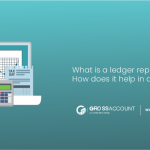Introduction
The world of businesses is changing their needs around the E-commerce platform. Because e-commerce platform is necessary for small businesses these days. So as it E-commerce Accounting. If you have a small or large business you need to know about E-commerce Accounting for your business’ health.
What is E-Commerce Accounting?
When businesses do organize their financial records around the e-commerce platform is called as E-Accounting. In this process, the whole e-commerce transaction is taken on the online platform. All details of debit and credit for one product consider in this.

Problem Faced by E-Commerce Platform Companies?
- Where to find your financial data
- COGS and Inventory Accounting
- Sales Tax Compliance
- Foreign Transaction Fees
1) Where to find your financial data while doing E-Commerce Accounting
For the typical businesses when they do their bookkeeping, most of their financial transaction are available in their bank account. But not in e-commerce accounting. In this accounting, things go messy.
In e-commerce accounting, you have your financial data in your sales channels and your payment processors. So it is difficult to get the right data. But more tension rises when your data is in multiple sales channels and payment processors. It is difficult to process that data and store it in one place.
So usually, you get a net deposit from the sales channel or payment processors in your bank account. So it is a net deposit, not the accurate revenue.
Ex. Let’s say you have a bank deposit of 5,000 rupees from your Amazon account. This deposit includes sales – shipping costs – FBA fees – gift card credit – sales tax (if any). So you have money in your account but it is not accurate. You may find sales more amount in the Amazon account. Let’s it has 20,000 rupees showing. Then it is likely to happen that 15,000 is deducted with these fees and taxes.
Why it is important?
Because it may find difficult when you would take your future business decision with this data. You may also find difficulties when you are going to sell your company.
So, before making decisions or doing any accounting you need to go through all your sales channels and payment processors. It is quite a task that can generate more errors. However, there are some tools available in the market that help you to do e-commerce accounting automatically. It transfers all your Amazon or Shopify or Flipkart money numbers to one accounting software.
Moreover, The main answer for this section is you should find your data in your sales channels and payment processors.
2) COGS and Inventory Management
COGS stands for the Cost of Goods Sold. It is the carrying value of goods sold during the month or some particular period. It is an essential metric in determining the profitability of a business and calculating the gross profit margin.
Businesses often encounter challenges when it comes to accurately accounting for their expenses related to inventory purchases. When businesses purchase inventory, they typically include all expenses associated with the acquisition.
However, this approach can lead to issues when calculating the COGS and evaluating the true profitability of the business.

Example:
January
- Sales – 1,00,000
- COGS – 90,000
- Gross Profit Margin – 10%
This indicates that the business has relatively low expenses compared to its sales
February
- Sales – 1,00,000
- COGS – 10,000
- Gross Profit Margin – 90%
This sudden decrease in COGS may indicate a potential problem with accurate expense allocation.
March
- Sales – 1,00,000
- COGS – 5,000
- Gross Profit Margin – 95%
This further highlights the inconsistency in expense allocation.
The main issue with this approach is that it does not accurately reflect the actual expenses incurred in the production or acquisition of the goods. As a result, the gross profit margin can be misleading, potentially leading to incorrect financial analysis and decision-making.
To address this problem, businesses need to develop robust inventory management systems that accurately track and allocate expenses associated with inventory purchases.
In summary, the problem of COGS and inventory management in e-commerce accounting revolves around the accurate allocation of expenses related to inventory purchases. By implementing proper systems and practices, businesses can ensure that their financial statements reflect the true cost of goods sold and make informed decisions based on accurate profit margins.
3) Sales Tax Compliance
Sales Tax Compliance refers to the process of collecting and remitting sales tax to different states. E-commerce businesses should comply with the sales tax regulation and requirements of every different state. It helps businesses to fulfil their tax obligations and avoid penalties.
However, Sales tax regulations can be complex and different across different states. small businesses may find difficulties to understand and comply the specific requirements of each state. Because e-commerce businesses are available on a global scale. Businesses should regularly be up to date about the changing regulations.
Most businesses find potential errors while collecting sales tax and doing their accounting. By implementing e-commerce accounting software businesses can address these challenges with ease. It reduces the errors and the risk of non-compliance.
4) Foreign Transaction Fees
E-Commerce companies in general have to deal with more foreign transactions and associated fees than other businesses. Businesses need to understand what are the fees of different countries.
Foreign transaction fees are charges imposed by financial institutions, such as credit card issuers or banks when a transaction is made in a foreign currency or with a merchant located in another country.
When it comes to e-commerce accounting, foreign transaction fees can create several problems and challenges for businesses. Foreign transaction fees add expense to each transaction made in a foreign currency. As a result, the overall cost of doing business internationally can be higher than anticipated, impacting profitability.
Foreign transaction fees may not be appropriately allocated in e-commerce accounting systems. Since these fees are often charged separately from the main transaction amount, they can be easily improperly recorded. This can lead to inaccurate financial statements.
To deal with the problems caused by foreign transaction fees in e-commerce accounting, businesses can consider Proper expense allocation. This can be done by some robust accounting software that tracks and record this transaction. Moreover, features like automation can streamline the payment gateway systems and easy to track transactions.
However, there are many tools available in the market. And choosing the right tool is essential for small businesses. These tools help to reduce a certain amount of fees while sending the package to other countries. You should look out for that. Some of them are Veem, Pluto, bill.com, etc.
Conclusion
In conclusion, small businesses may find these problems while doing their e-commerce accounting. Changing the nature of taxes and laws can cause some difficulties. Businesses might need to address these challenges. A good accounting software or market tool can reduce errors to compile these problems. GrossAccount provides you with accounting software that might help you to get streamline your accounting process effectively.






